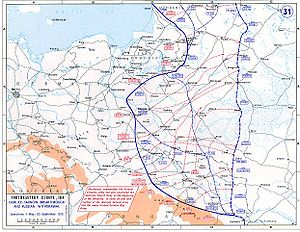| Vilno-Dvinsk offensive | |||||||||
|---|---|---|---|---|---|---|---|---|---|
| Part of the Eastern Front of World War I | |||||||||
 Russian withdrawal in 1915. | |||||||||
| |||||||||
| Belligerents | |||||||||
|
|
| ||||||||
| Commanders and leaders | |||||||||
| Units involved | |||||||||
| Strength | |||||||||
| 948,048[5] |
On all front: 1,911,157[6]
| ||||||||
| Casualties and losses | |||||||||
| 116,187[b] | 80,000[c] to 376,574[d] | ||||||||
The Vilno-Dvinsk offensive (Russian: Виленская операция) or Battle of Vilnius (German: Schlacht bei Wilna) took place in the autumn of 1915 between the cities of Vilnius and Daugavpils. It was strategic withdrawal by Russian forces on the Eastern Front of World War I, after a successful summer German offensive. The German armies were under the command of Supreme Commander of All German Forces in the East, Field Marshal Paul von Hindenburg. Although weakened by the transfer of 12 divisions to France and the Balkans, as part of taking a defense, Hindenburg had his forces conduct several secondary offensive operations. Half of the Russian forces and the main German forces on the eastern front took part in the battle.[9] However, the numerical superiority of the Russians did not allow Hindenburg to achieve a lasting success. Further actions for the Germans were unsuccessful as they suffered losses without achieving their goal of taking Daugavpils.[4][10]
- ^ Олейников 2016, pp. 133–135.
- ^ Borisyuk 2024, p. 120.
- ^ Олейников 2016, p. 133.
- ^ a b Борисюк 2023, p. 90.
- ^ Deutsches Reich. Heeres-Sanitätsinspektion 1935, Table 11.
- ^ a b c Нелипович 2022, p. 718.
- ^ Borisyuk 2024, p. 104.
- ^ Oleynikov 2024, p. 340-341.
- ^ Oleynikov 2024, p. 304.
- ^ Олейников 2016, p. 133-135.
Cite error: There are <ref group=lower-alpha> tags or {{efn}} templates on this page, but the references will not show without a {{reflist|group=lower-alpha}} template or {{notelist}} template (see the help page).